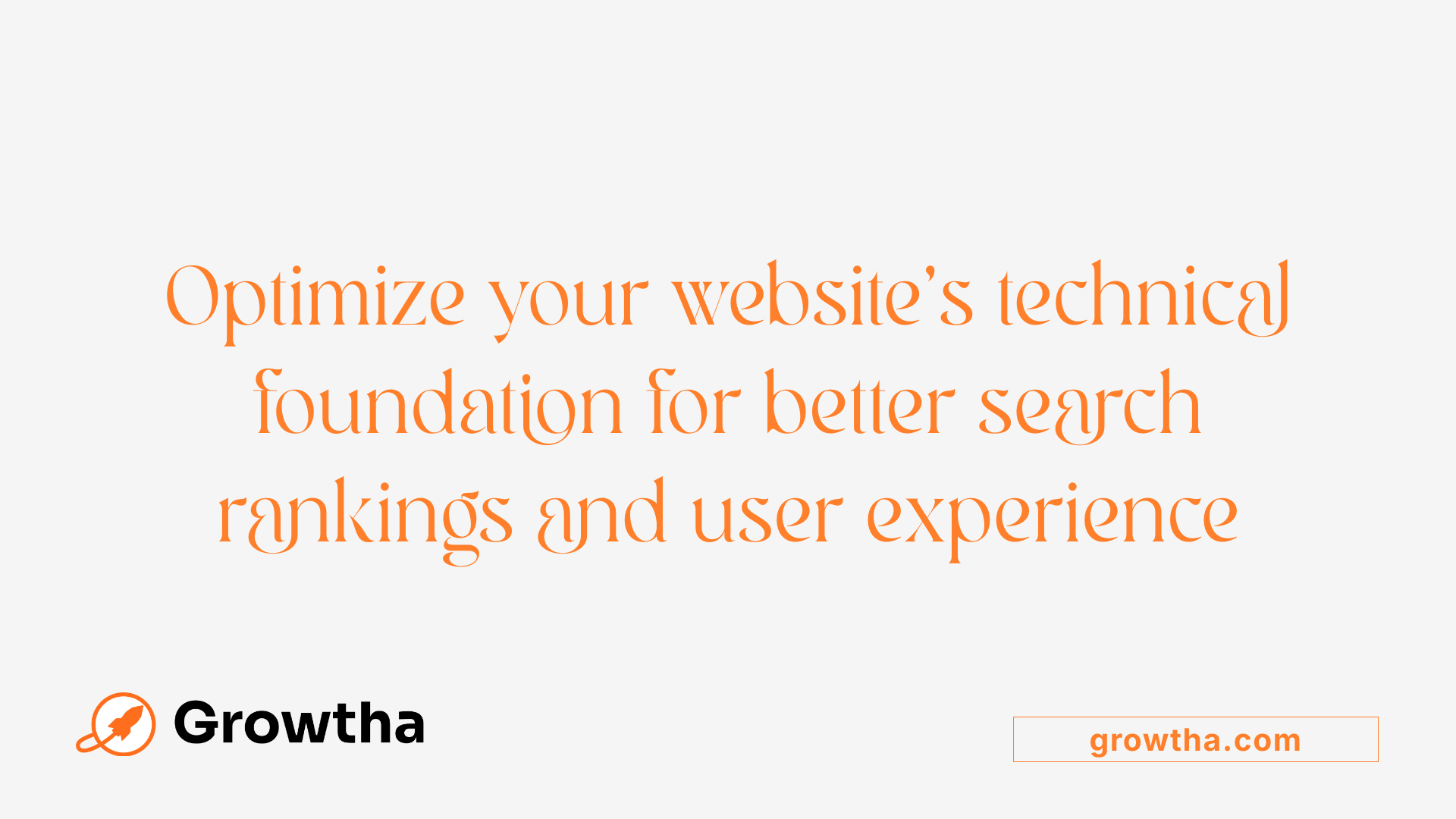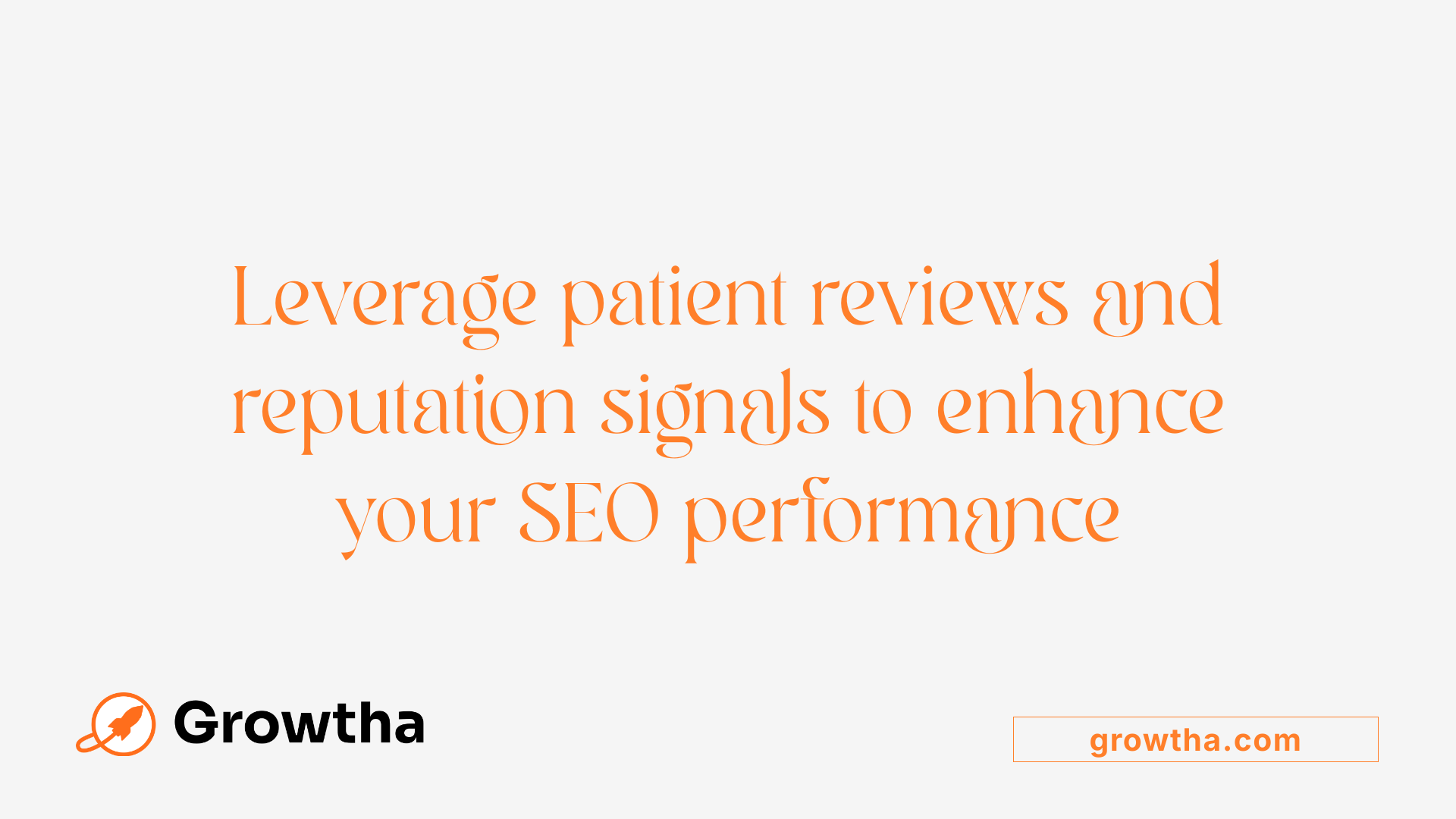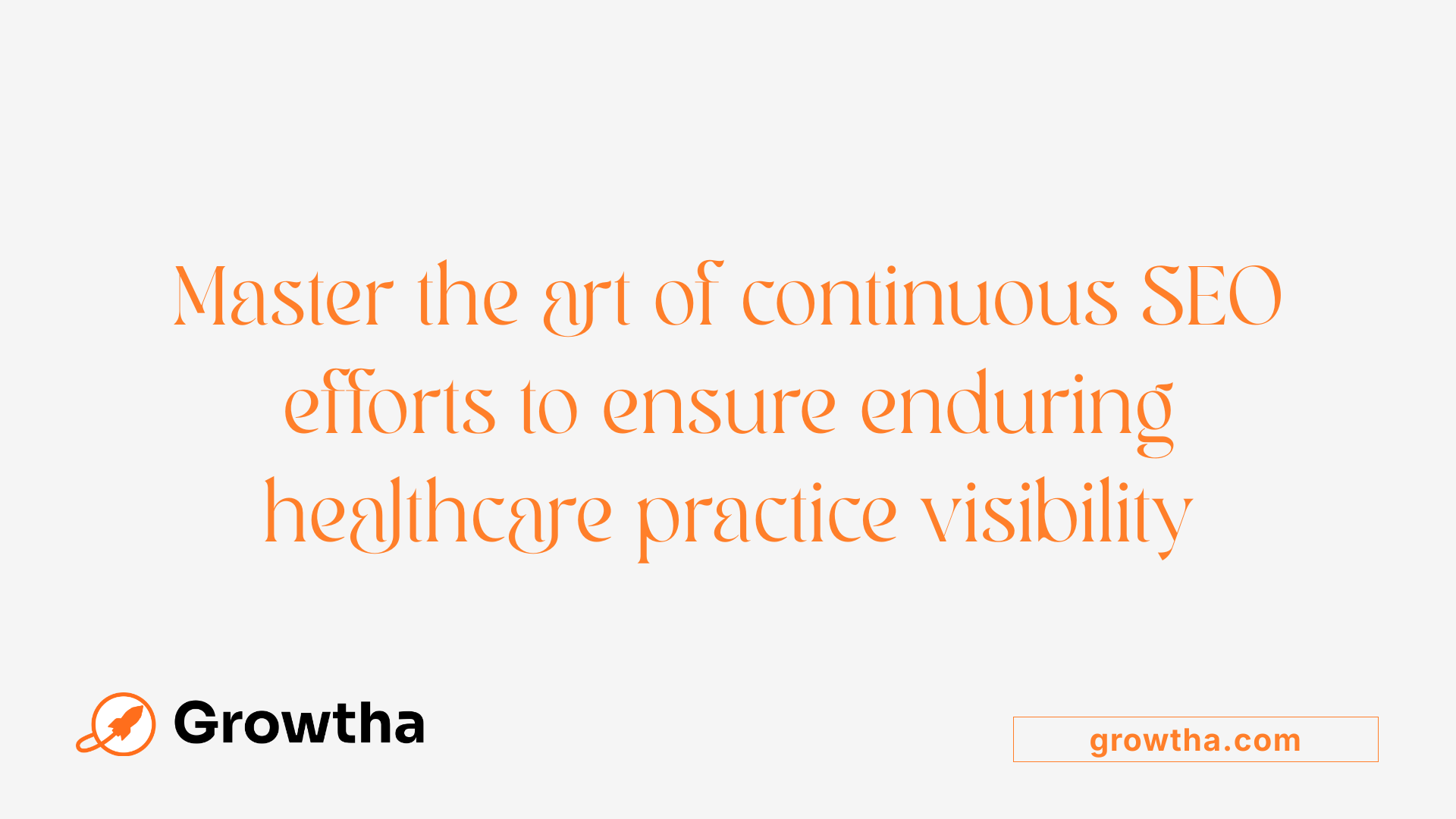How to Track SEO Success for Doctors and Clinics
Maximizing Healthcare Visibility Through Effective SEO Tracking


How to Track SEO Success for Doctors and Clinics
Understanding the Importance of SEO in Healthcare
In today's digital age, over 80% of patients search for healthcare providers online. Achieving high visibility in search engine results is essential for doctors and clinics to attract new patients and build their reputation. However, measuring the success of SEO efforts requires a strategic approach, involving precise metrics, KPIs, and ongoing assessment. This article will explore comprehensive strategies for tracking SEO success tailored specifically for healthcare practices, ensuring sustainable growth and improved patient engagement.
Core Components of Healthcare SEO and Their Measurement
How can healthcare providers measure and evaluate SEO success?
Healthcare providers can measure SEO success through various metrics that offer insights into their online visibility and patient engagement. Quantitative data such as organic search traffic, keyword rankings, click-through rates, bounce rates, and conversions (appointment bookings or inquiries) are fundamental indicators. Regular use of analytics tools like Google Analytics and Google Search Console helps track these metrics, revealing how users interact with the website and which strategies are effective.
Assessing backlinks, local search visibility, and website authority through reputable backlinks and local listings also paints a comprehensive picture. Technical factors—such as site speed, mobile responsiveness, and Core Web Vitals—are vital for maintaining a high-ranking website.
Combining these measurable indicators with qualitative assessments, such as content relevance and trustworthiness, enables healthcare providers to evaluate their SEO efforts effectively. This ongoing analysis guides strategic optimization, ensuring continuous improvement in search rankings and patient engagement.
What are the key metrics and KPIs for tracking SEO performance in medical practices?
Tracking SEO performance in medical practices involves several crucial metrics and KPIs. These include:
| Metric/KPI | Purpose | Measurement Tools |
|---|---|---|
| Organic Traffic | Measures overall website visits from search engines | Google Analytics |
| Keyword Rankings | Tracks positions for targeted health-related keywords | SEMrush, Ahrefs |
| Bounce Rate | Assesses visitor engagement and site relevance | Google Analytics |
| Conversion Rate | Indicates effectiveness in turning visitors into patients | Google Analytics, Booking systems |
| Local Search Visibility | Evaluates presence in local search results | Google My Business insights |
| Backlink Quality | Gauges website authority | Ahrefs, Moz |
| Page Load Speed & Mobile Responsiveness | Ensures good user experience | Google PageSpeed Insights |
| Review Quantity & Ratings | Builds credibility and trust | Google Reviews, Healthgrades |
Monitoring these factors helps practices optimize their online presence, attract high-intent patients, and refine marketing strategies.
How can medical practices assess the ROI of their SEO efforts?
Assessing SEO ROI requires linking investments to tangible results. Practices should track key indicators such as organic traffic growth, increased appointment inquiries, and new patient conversions attributed to search efforts. Using analytics tools like Google Analytics and Search Console, clinics can gather data on the number of leads generated from SEO activities.
Calculating ROI involves the formula: ((Revenue from SEO - Cost of SEO) / Cost of SEO) × 100%. For example, if a practice earns $10,000 from patients who found them through search and spent $2,000 on SEO, the ROI is 400%. It’s essential to assign revenue to specific SEO conversions and adjust for long-term patient value.
Additionally, tracking local search improvements, call volume, and reviews further demonstrate SEO effectiveness. This comprehensive approach ensures practices understand the value generated by their SEO investment.
Is there a step-by-step guide for evaluating SEO success in healthcare?
Yes, healthcare providers can follow a structured process to evaluate SEO success:
- Conduct an initial SEO audit covering technical health, site structure, and healthcare-specific compliance.
- Define clear, measurable goals aligned with patient acquisition, such as increasing local visibility or inquiries.
- Identify relevant KPIs like organic traffic, keyword rankings, bounce rate, and backlinks.
- Regularly monitor these metrics using tools like Google Analytics, Search Console, SEMrush, or Ahrefs.
- Analyze performance data periodically to identify strengths and areas needing improvement.
- Adjust SEO strategies based on insights, focusing on high-impact tactics like content updating, backlink building, and local SEO.
- Continually track progress over time, benchmarking against competitors and industry standards.
This ongoing cycle helps healthcare practices maintain and improve their SEO effectiveness over the long term.
What methods exist for monitoring and improving a healthcare website's online visibility and search rankings?
To enhance a healthcare website’s visibility, practices should implement a combination of technical and content strategies. Regular SEO audits identify crawl issues, broken links, and site speed problems.
Optimizing site architecture with structured data, local schema markup, and siloed content improves search engine understanding and ranking. Conducting keyword research ensures content aligns with what patients are searching for.
Tracking keyword positions and analyzing website analytics reveal performance trends. Creating high-quality, relevant content bolsters authority and trust, while local SEO efforts—like optimizing Google My Business profiles and consistent NAP information—improve local rankings.
Building backlinks from reputable healthcare sources and ensuring mobile responsiveness with fast load times are essential tactics. Incorporating voice search optimization and accessibility features further aligns the site with modern search behaviors.
All these efforts, coupled with continuous performance monitoring, drive sustained improvement in search engine rankings and patient engagement.
What are the specific SEO performance indicators relevant to medical practices?
Relevant SEO indicators for medical practices include:
- Local search rankings and visibility in Google Maps and local packs
- Organic traffic volume and user engagement metrics
- Keyword ranking positions for targeted healthcare terms
- Bounce rate and average session duration
- Conversion metrics like appointment bookings and contact form submissions
- Quality and quantity of backlinks
- Review ratings and reputation scores
- Website technical health (speed, mobile-friendliness, and schema markup)
- Click-through rates from search results
Tracking these indicators helps practices to optimize their content, technical setup, and local SEO efforts, ultimately increasing patient inquiries and practice growth.
Are there best practices for tracking the effectiveness of healthcare SEO campaigns?
Yes, effective tracking involves establishing clear objectives, such as increased patient inquiries or improved search rankings. Utilize analytics tools like Google Analytics and Search Console to monitor key metrics regularly.
Regularly review local SEO performance through Google My Business insights and review management platforms. Track backlinks quality and content engagement to understand authority and trustworthiness improvements.
Implementing a consistent reporting structure, benchmarking against competitors, and analyzing trends over time are crucial. Make data-driven adjustments, such as refining keywords, enhancing content quality, and fixing technical issues.
These practices ensure that healthcare SEO campaigns remain aligned with practice goals, compliant with regulations, and continuously optimized for better results.
Local SEO Strategies and Their Impact on Healthcare Visibility
How can healthcare providers measure and evaluate SEO success?
Healthcare providers can measure SEO success by tracking a comprehensive set of metrics, including organic search traffic, keyword rankings, click-through rates, bounce rates, and conversion rates such as appointment bookings or inquiries. Regular monitoring with analytics tools like Google Analytics and Search Console helps assess visibility, engagement, and user behavior, while benchmarking against competitors. Additionally, measuring backlinks, local pack rankings, and website authority through high-quality backlinks and local listings provides insight into overall SEO health. Evaluating technical factors such as site speed, mobile responsiveness, and Core Web Vitals ensures the website delivers a good user experience, which positively impacts rankings. Combining these quantitative measures with qualitative indicators like content authority and trustworthiness enables healthcare providers to gauge their SEO effectiveness and guide ongoing optimization efforts.
What are the key metrics and KPIs for tracking SEO performance in medical practices?
The principal indicators include organic traffic growth, search engine ranking positions, click-through rates from search results, bounce rates, conversion metrics such as appointment inquiries, and local pack visibility. Monitoring the number and quality of backlinks, reviews, and ratings also provides insights into domain authority and reputation. Technical SEO factors—like website speed, mobile usability, and schema markup implementation—are essential for user experience and ranking. Using tools such as Google Analytics, Google Search Console, SEMrush, and Ahrefs helps gather these data points. Regularly evaluating these metrics before and after optimization allows practices to understand the impact of their SEO efforts and refine strategies accordingly.
How can healthcare providers measure and evaluate SEO success?
Healthcare providers can evaluate their SEO through multiple channels. It begins with tracking website traffic and rankings to observe increases in visibility. Patient inquiries, appointment bookings originating from search, and local search rankings in Google My Business are vital indicators of effectiveness. Call tracking software helps attribute patient calls to specific campaigns or keywords, enhancing understanding of conversion sources.
Tools like Google Analytics and Search Console provide data on visitor behavior, engagement, and technical performance. Benchmarking against competitors and analyzing backlink profiles and review scores reveal areas for improvement. Additionally, monitoring content engagement and website speed ensures an optimal user experience. Combining these quantitative indicators with qualitative assessments—such as content relevance and online reputation—enables healthcare providers to continually assess, adjust, and improve their SEO strategies.
What are the best practices for local SEO in healthcare?
Effective local SEO practices include optimizing the Google Business Profile with accurate, complete healthcare-specific information, including services, hours, and contact details. Utilizing location-specific keywords naturally within website content helps attract relevant local searches. Maintaining consistent NAP (Name, Address, Phone number) details across all online directories is crucial for boosting local rankings.
Building and managing positive reviews on Google My Business and other review sites influence both reputation and local SEO rankings. Responding professionally to reviews fosters trust and encourages more feedback. Developing local backlinks from healthcare directories, community organizations, and industry partners enhances domain authority. Additionally, creating localized content—such as FAQs addressing regional health issues or community health updates—improves relevance. Ensuring the website is mobile-responsive with fast load times and implementing schema markup tailored for local businesses further enhances visibility in local search results.
How does reputation management influence healthcare SEO success?
Reputation management has a profound effect on healthcare SEO because online reviews and patient testimonials directly impact search rankings and patient trust. Positive reviews increase click-through rates from local search results and serve as social proof of quality care, which search engines interpret as signals of authority.
Encouraging satisfied patients to leave reviews on Google My Business and healthcare review platforms improves online reputation and local visibility. Addressing negative feedback promptly and professionally demonstrates commitment to patient satisfaction and helps mitigate reputational damage. Regularly monitoring and responding to reviews cultivates a positive online presence, fostering patient confidence and enhancing SEO performance. This cycle of active reputation management contributes to higher rankings, increased online recognition, and ultimately, more patient inquiries and appointments.
Technical SEO and Website Optimization for Healthcare Practices

What methods exist for monitoring and improving a healthcare website's online visibility and search rankings?
Monitoring and enhancing a healthcare website’s search performance involve a combination of technical audits and ongoing analysis. Conducting comprehensive technical SEO audits using tools like Google Search Console and Lighthouse helps identify issues such as crawl errors, slow loading times, or accessibility problems. Optimizing site architecture ensures easier indexing—this includes creating a clear URL structure and internal linking.
Implementing structured data markup, particularly schema.org vocabularies relevant to healthcare, improves how search engines interpret site content, leading to richer search listings. Tools like Google Search Console allow tracking of crawl errors and indexation status, while performance monitoring is facilitated through Google Analytics and rank tracking software like SEMrush or Ahrefs.
Enhancing website speed and responsiveness is critical. Techniques such as compressing images, leveraging browser caching, minimizing code, and utilizing Content Delivery Networks (CDNs) can substantially improve load times. Regularly updating content, maintaining NAP consistency in local listings, and ensuring mobile-friendliness also support better rankings.
HIPAA compliance and accessibility standards (like ADA) should be integrated into website design, maintaining trust and legal standards. Overall, a proactive, data-driven approach with continuous adjustments ensures healthcare practices stay visible and competitive online.
What are the specific SEO performance indicators relevant to medical practices?
Healthcare providers need to focus on tailored SEO metrics that directly track their online success. These include:
| Performance Indicator | Description | Why It Matters |
|---|---|---|
| Organic Traffic | Number of visitors arriving via search engines | Indicates overall visibility and reach |
| Search Rankings | Position of the website for targeted keywords | Higher rankings increase patient trust and clicks |
| Local Search Rankings | Ranking in local pack and map results | Crucial for attracting nearby patients |
| Click-Through Rate (CTR) | Percentage of searchers clicking search results | Reflects relevance and attractiveness of listings |
| Patient Inquiries & Bookings | Number of appointment requests or calls | Direct measure of conversion from SEO efforts |
| Review Quantity & Quality | Number of positive reviews and star ratings | Builds reputation and trustworthiness |
| Bounce & Engagement Rates | Visitor behaviors, time on site | Showcase website engagement and content effectiveness |
| Backlink Quality | Authority and number of inbound links | Indicates domain trust and influence |
| Keyword Rankings | Positions for specific healthcare-related keywords | Guides content and optimization focus |
Tracking these indicators provides a comprehensive view of SEO health, allowing continuous optimization and clearer ROI measurement.
How does structured data markup improve healthcare search visibility?
Implementing structured data markup, such as schema.org tags, significantly enhances how search engines view healthcare websites. Rich snippets generated through schema—like star ratings, doctor profiles, locations, and FAQ sections—make listings more attractive and informative in search results.
For doctors and clinics, applying schema for local business details, reviews, and medical services increases the likelihood of appearing in enhanced search features, including local packs and rich snippets. This not only improves visual appeal but also boosts click-through rates.
Structured data supports Google's authority and trust signals, especially when aligned with E-E-A-T (Experience, Expertise, Authority, Trust). When search listings display verified credentials, reviews, and comprehensive information, patients are more confident selecting that practice.
Additionally, schema markup aids voice search optimization and accessibility compliance, ensuring the website captures modern search behaviors and reaches a broader audience.
How does site architecture influence healthcare SEO?
The design of a website's structure is fundamental to its SEO success. A clear, hierarchical architecture ensures search engines can efficiently crawl and index all relevant content. Organized siloing of topics—patients’ symptoms, treatments, doctor bios—helps establish topical authority and improves keyword relevancy.
Logical navigation, with breadcrumb trails and internal links, enhances user experience and helps visitors find pertinent information quickly. Fast-loading pages with clean URL structures not only benefit users but also facilitate better search rankings.
Mobile responsiveness is a vital aspect of site architecture, considering the increasing prevalence of mobile health searches. Furthermore, implementing schema markup within the architecture helps search engines understand content context, giving the practice a competitive advantage.
Balancing regulatory compliance, such as HIPAA, with a user-friendly design builds trust and credibility. A well-structured website boosts engagement, encourages longer visits, and results in higher rankings—essential for attracting high-quality patient leads.
Content Strategy and Creation for Healthcare SEO Success

How can healthcare providers measure and evaluate SEO success?
Measuring SEO success involves tracking various metrics that reflect online visibility, patient engagement, and revenue impact. Common tools such as Google Analytics and Google Search Console help monitor website traffic, search rankings, and user interactions. Conversion metrics—such as appointment bookings, phone inquiries, and patient form submissions—are vital indicators of effectiveness. Call tracking software enables practices to attribute patient inquiries directly to SEO efforts. These combined data points help assess whether SEO strategies are increasing patient leads and ultimately boosting revenue.
What are the key metrics and KPIs for tracking SEO performance in medical practices?
Monitoring SEO performance relies on multiple indicators. Key performance metrics include organic traffic volume, keyword ranking positions, and local search visibility. Conversion rates, representing visits that lead to appointments, are crucial to gauge real-world results. Additionally, tracking reviews and reputation scores via platforms like Google My Business enhances credibility. Specific KPIs involve local search rankings, website bounce rate, session duration, pages per session, and direct inquiry counts from online sources. Regularly analyzing these data points allows practices to adjust strategies for ongoing improvement.
How can healthcare practices assess the ROI of their SEO efforts?
Calculating the return on investment (ROI) of healthcare SEO involves comparing generated revenue against SEO costs. The formula used is: ((Revenue from SEO - SEO Costs) / SEO Costs) × 100%. For example, if a practice earns $10,000 from SEO-driven patient bookings with an investment of $2,000, the ROI is 400%. To accurately evaluate ROI, practices must assign revenue to specific conversions, track changes over time, and consider long-term growth. Implementing clear goals regarding increased traffic, patient inquiries, and appointments helps translate SEO activities into tangible financial results.
What methods exist for monitoring and improving a healthcare website's online visibility and search rankings?
Practices can employ multiple techniques to monitor and enhance their search engine presence. Regular use of Google Search Console offers insights into search performance, indexing status, and technical issues. Analytics platforms like Google Analytics reveal visitor behavior and conversion paths. Benchmarking tools such as SEMrush or Ahrefs aid in competitor analysis, keyword optimization, and backlink strategies. Improving website visibility involves optimizing on-page elements—meta descriptions, headers, and schema markup—ensuring mobile responsiveness, and enhancing page load speeds through image compression and strategic code improvements. Addressing technical SEO aspects guarantees that search engines easily crawl and index the site, while ongoing reputation management and content updates maintain relevance and authority.
Creating Engaging Content and Building Authority

How can developing educational and authoritative content benefit healthcare SEO?
Creating content that is both informative and trustworthy helps healthcare practices establish authority in their field. Well-researched articles, patient resources, and detailed service descriptions improve search engine rankings while providing real value to patients. This approach attracts high-quality traffic and encourages visitors to trust your expertise.
Why is answering patient questions with FAQs important?
FAQs address common patient concerns, improve user experience, and boost SEO by incorporating relevant keywords naturally. They help your website rank for voice search queries and long-tail keywords related to specific treatments or symptoms. Clear, concise answers also build confidence and credibility.
How can multimedia like videos and infographics enhance content?
Incorporating videos, infographics, and images makes content more engaging and easier to understand. Videos featuring doctor introductions or patient testimonials can increase time spent on your site, while infographics can simplify complex medical information. These elements also improve chances of being shared and linked, boosting your authority.
What are E-E-A-T principles, and how do they improve website trustworthiness?
E-E-A-T stands for Experience, Expertise, Authority, and Trustworthiness. Applying these principles means creating content that demonstrates medical experience, cites reputable sources, and includes credentials of healthcare providers. This not only aligns with Google’s quality guidelines but also reassures patients about the accuracy and reliability of your information.
What are the specific SEO performance indicators relevant to medical practices?
Measuring SEO success involves tracking several metrics:
| Indicator | Description | How It Helps Improve SEO |
|---|---|---|
| Organic Traffic | Visitors arriving through search engines | Shows visibility and reach |
| Search Rankings | Your website’s position for targeted keywords | Indicates keyword optimization success |
| Conversion Rate | Patients making appointments or inquiries | Reflects content effectiveness |
| Local Search Rankings | Visibility in local search results | Critical for attracting nearby patients |
| Call and Inquiry Metrics | Phone calls and contact form submissions | Direct measures of engagement |
| Keyword Positions | Rankings for specific search terms | Helps refine keyword strategy |
Are there best practices for tracking the effectiveness of healthcare SEO campaigns?
Yes. Regularly analyzing data using tools like Google Analytics and Search Console provides insights into website traffic, user engagement, and search performance. Monitoring local SEO metrics through Google Business Profile insights helps evaluate visibility in local searches. Comparing performance before and after implementing strategies reveals what works best.
Why is consistent tracking essential?
Continuous monitoring allows healthcare practices to identify which tactics deliver results and which need adjustment. It ensures resources are allocated efficiently, enhances patient acquisition strategies, and ultimately improves ROI.
How does understanding these metrics help refine your SEO approach?
By analyzing performance indicators, practices can identify content gaps, optimize underperforming keywords, and improve user experience. This data-driven approach enhances long-term growth and maintains a competitive edge in healthcare SEO.
| Performance Metric | Tool Used | Typical Benchmark | Purpose |
|---|---|---|---|
| Website Traffic | Google Analytics | Varies by practice | Measure overall visibility |
| Keyword Rankings | SEMrush, Ahrefs | Top 3 to 10 positions | Track ranking improvements |
| Local Pack Visibility | Google Business Profile Insights | Increased views and calls | Boost local search presence |
| Conversion Rate | Google Analytics, Call Tracking | Industry-specific benchmarks | Assess patient inquiry success |
| Review Quantity & Quality | Google Reviews, Reputation management tools | Growing positive reviews | Build reputation and trust |
Implementing these strategies with an understanding of monitoring tools and metrics ensures your healthcare SEO efforts are effective and aligned with your practice’s growth objectives.
Local SEO and Content Optimization
How can healthcare providers target local keywords and phrases?
In healthcare SEO, incorporating location-specific keywords is essential for attracting local patients. Practices should conduct keyword research to identify popular search terms like "doctor in [city]," "pediatrician near me," or "urgent care in [area]." These keywords should be naturally integrated into website content, page titles, meta descriptions, and headers. Using tools such as SEMrush or Ahrefs can help identify relevant local keywords and track their performance.
What strategies are effective for developing localized content?
Creating localized content helps improve visibility in local searches and builds community trust. This includes blog posts about local health events, guides on the best practices for health issues prevalent in the area, and patient resources tailored to the community’s needs. Incorporating location references and local landmarks makes content more relevant. Regularly updating this content ensures ongoing engagement and relevance.
How should doctor bios and services be optimized for local search?
Doctor bios should include location references and keywords relevant to the area, emphasizing local community involvement and specialties. Clearly listing services with local keywords further enhances search relevance. Ensuring each profile is complete, accurate, and includes a local contact detail builds trust and local authority. Adding testimonials from local patients and combining this with geo-tagged images enriches the profile's local appeal.
What is the importance of creating location-specific pages?
Location-specific pages enable practices to target different geographic areas they serve. For instance, a practice with multiple clinics can have dedicated pages for each location, optimized with localized content, maps, and contact details. These pages help capture search traffic for specific areas, improve rankings in local search results, and provide potential patients with relevant information about nearby clinics.
How can internal linking enhance local relevance?
Strategic internal linking connects various local pages and relevant blog posts, spreading link equity throughout your website. Linking from high-authority site pages to local pages boosts their search visibility. Using descriptive anchor text with local keywords helps search engines associate those pages with relevant local searches. Internal links also guide visitors to related services or resources, increasing engagement.
What are the best practices for local SEO in healthcare?
Best practices include maintaining consistent NAP (Name, Address, Phone number) information across all directories and your website, verifying and optimizing your Google Business Profile, actively managing reviews, and building backlinks from reputable local sources. Ensuring your website is mobile-responsive, fast, and structured with local schema markup also boosts your local SEO efforts.
How does reputation management influence healthcare SEO success?
Patient reviews and testimonials play a crucial role in local SEO. Positive reviews enhance your practice’s credibility, increase local search rankings, and influence patient decisions. Encouraging satisfied patients to leave reviews, responding professionally to feedback—both positive and negative—and addressing concerns promptly help build a strong reputation.
What tools and metrics are useful for tracking local SEO performance?
Monitoring local SEO involves tracking rankings for targeted keywords, analyzing website traffic sources, and measuring appointment inquiries or calls generated from local searches. Tools like Google Search Console and Google Analytics provide insights into search visibility and user behavior. Local citation tools, review management software, and position tracking platforms further assist in evaluating local SEO success.
Below is a summary table consolidating these strategies:
| Strategy | Description | Benefits |
|---|---|---|
| Local Keyword Optimization | Integrate specific city and neighborhood keywords naturally into website content | Increases visibility for targeted searches |
| Localized Content Creation | Develop blog posts, guides, and resource pages relevant to local community | Engages patients and boosts local relevance |
| Local Profile Optimization | Complete and verify Google Business Profile, optimize doctor bios | Enhances local search appearance |
| Location-specific Pages | Create dedicated pages for each service area | Captures more local search traffic |
| Internal Linking | Use strategic links to connect local and relevant content | Improves site authority and user navigation |
| Reputation Management | Collect and respond to patient reviews | Builds trust and improves rankings |
| Performance Monitoring | Use analytics and tools to track local SEO metrics | Allows data-driven improvements |
Adopting these localized content strategies ensures healthcare practices effectively reach their community, reinforcing their online presence and patient trust. Read more about this approach by searching "Local SEO content strategies in healthcare."
Integrating Reviews and Reputation Signals into SEO Tracking

How does reputation management influence healthcare SEO success?
Reputation management plays a crucial role in healthcare SEO, as positive reviews and strong online reputation directly impact search engine rankings and patient trust. Clinical practices with numerous favorable reviews tend to appear higher in local search results, which enhances visibility.
Online reviews serve as social proof, reassuring prospective patients about the quality of care. When reviews consistently highlight positive experiences, search engines interpret this as a signal of authority and trustworthiness, thus boosting rankings. Additionally, a robust reputation increases click-through rates from search results, further improving SEO performance.
Negative reviews, if managed properly, can be turned into opportunities to demonstrate excellent patient care. Ignoring reviews or neglecting reputation can harm your practice’s online credibility, leading to decreased rankings and potential loss of patient inquiries.
Encouraging patient reviews and testimonials
To foster a steady flow of positive reviews, healthcare providers should actively request feedback after appointments. Simplifying the review process via direct links to Google Business Profile, or other local directories, encourages patients to share their experiences.
Strategies include:
- Using follow-up emails or text messages requesting feedback.
- Displaying signage in the clinic prompting reviews.
- Offering incentives or explanations of how reviews help future patients.
Quality reviews should be genuine, balanced, and provide specific insights about services received.
Responding to reviews professionally
Responding promptly and professionally to both positive and negative reviews is vital. A courteous reply to positive reviews reinforces patient satisfaction and encourages continued engagement.
For negative reviews, responses should be empathetic, acknowledge concerns, and offer solutions or direct communication channels to resolve issues. Maintaining professionalism demonstrates accountability, which can mitigate damage and demonstrate responsiveness.
Tracking review metrics and sentiment analysis
Monitoring your review metrics involves analyzing quantity, star ratings, and content sentiment. Tools like Google My Business dashboard, reputation management platforms, or custom sentiment analysis software can help track and interpret reviews.
Sentiment analysis helps gauge overall patient satisfaction and identify recurring themes that require attention. Regular review audits enable practices to identify patterns that may influence search rankings or reputation management strategies.
Leveraging reviews to boost local SEO
Reviews are integral to local SEO, as they contribute to your practice’s prominence in local search results and Google’s local pack. Consistent positive reviews containing relevant local keywords improve your visibility for area-specific searches.
Enhancing local SEO involves:
- Ensuring reviews mention your location or services explicitly.
- Keeping NAP (Name, Address, Phone number) consistent across review platforms.
- Incorporating keywords naturally within review responses.
- Highlighting positive reviews on your website and social media to build authority.
By actively managing reviews, optimizing responses, and analyzing sentiment, healthcare practices can significantly improve their online presence, attract high-quality, local patients, and strengthen their reputation overall.
Utilizing SEO Tools for Performance Monitoring and Analysis
Google Analytics and Search Console
Google Analytics and Google Search Console are foundational tools for tracking and analyzing the performance of healthcare SEO efforts. Google Analytics provides comprehensive data on website visitors, including user demographics, behavior, session duration, and conversion pathways. It helps healthcare providers understand how visitors interact with their site, which pages are most engaging, and where drop-offs occur.
Google Search Console offers insights specifically related to search engine performance, such as keyword rankings, click-through rates, impressions, and indexing status. It identifies technical issues like crawling errors or site health problems which can affect search visibility. Regularly reviewing data from both tools ensures providers can spot trends, optimize content, and improve user experience.
SEMrush, Ahrefs for Competitor Analysis
SEMrush and Ahrefs are powerful SEO platforms used to analyze competitors and identify opportunities for improvement. They provide detailed insights into competitors' keyword rankings, backlink profiles, content strategies, and overall domain authority.
By benchmarking against competitors, healthcare practices can pinpoint gaps in their own SEO, discover high-performing keywords, and uncover backlink opportunities to boost authority. These tools facilitate strategic adjustments, such as creating targeted content to outrank competitors or acquiring backlinks from reputable healthcare sources, enhancing overall search performance.
Rank Tracking Tools for Keyword Performance
Effective SEO monitoring involves tracking the rankings of targeted keywords over time. Rank tracking tools like SEMrush, Ahrefs, and BrightLocal enable practices to see where their website appears in search engine results pages (SERPs) for relevant local and medical keywords.
Regular rank tracking helps evaluate the impact of optimization efforts and provides data to refine keyword strategies. Changes in rankings can indicate the effectiveness of recent content updates or technical SEO fixes, guiding ongoing adjustments for continuous visibility improvement.
Call Tracking for Attribution and Conversion Measurement
Call tracking software is critical for attributing patient inquiries to specific campaigns, keywords, or sources. Implementing call tracking numbers across website pages and Google My Business profiles allows practices to measure which channels generate phone inquiries and conversions.
This attribution data links SEO activities with actual patient engagement, helping providers evaluate ROI. By analyzing call data, healthcare practices can optimize their local SEO strategies, improve patient follow-up, and refine marketing messages to increase appointment bookings.
Are there best practices for tracking the effectiveness of healthcare SEO campaigns?
Yes, effective measurement involves combining multiple tools and metrics. Regularly reviewing analytics from Google Analytics and Search Console provides insights into website performance and search presence. Benchmarking against competitors with SEMrush or Ahrefs reveals competitive positioning and content gaps.
Tracking keyword rankings enables monitoring of organic visibility for critical terms. Call tracking and conversion tracking tie online activity directly to patient inquiries. Combining these approaches with setting clear goals—such as increasing appointment bookings or local search traffic—ensures healthcare providers can accurately evaluate their SEO success.
Using these tools systematically helps practices make data-driven decisions, optimize ongoing campaigns, and demonstrate measurable ROI from SEO efforts.
More Information Search Query
To explore further, search for "SEO performance tools for healthcare providers" to find the latest platforms, reviews, and best practices tailored to medical practices' unique needs.
Long-term Strategies for Sustaining SEO Success

Continuous Content Update and Creation
Maintaining a strong online presence in healthcare requires ongoing content efforts. Regularly updating existing content ensures accuracy, especially given the fast-evolving nature of medical information. Creating new, high-quality articles, videos, and patient resources helps address the latest trends, common questions, and local health concerns. This continual flow of fresh content not only keeps visitors engaged but also signals to search engines that the website remains active and authoritative.
Incorporating patient-centric topics and aligning content with E-A-T principles (Expertise, Authoritativeness, Trustworthiness) further enhances search rankings. Effective content strategies should include answering FAQs, explaining procedures, and providing updates on new treatments or health guidelines relevant to the local community. Consistent content creation also boosts long-term keyword rankings, attracting high-intent patients actively searching for specific services.
Backlink Profile Management
A robust backlink profile is essential for SEO authority and improved search engine rankings. Healthcare providers should aim to earn backlinks from reputable medical and local community sites, industry publications, and trusted health blogs. These backlinks act as endorsements for the website's credibility, reinforcing trustworthiness and authority.
Regularly auditing backlink profiles helps identify and disavow toxic or spammy links that could harm the site’s reputation. Outreach efforts for guest posting, partner collaborations, and digital PR campaigns can foster natural link acquisition. Building relationships with other healthcare providers, local organizations, and health influencers can generate sustainable backlinks that sustain SEO efforts.
Regular Technical Audits
Technical SEO forms the backbone of a healthy healthcare website. Routine technical audits ensure website architecture, schema markup, mobile responsiveness, and page speed meet the latest standards. Optimizing site structure with a clear hierarchy, clean URLs, and structured data helps search engines crawl and index content effectively.
Implementing schema markup for local business information, services, and patient FAQs enhances appearance in local search results. Monitoring page speed improvements through tools like Google PageSpeed Insights, and fixing issues such as broken links or duplicate content, are vital for a seamless user experience. Regular audits ensure ongoing compliance with healthcare standards and accessibility requirements, such as ADA compliance.
Staying Compliant with Healthcare Regulations
Healthcare SEO must align with industry regulations to protect patient data and ensure ethical marketing practices. Staying updated on laws like HIPAA in the U.S. or GDPR in Europe is crucial when handling patient reviews, testimonials, or any patient-related online content.
Implementing secure website protocols, maintaining confidentiality, and avoiding misleading claims are foundational. Collaboration with legal and compliance teams ensures that SEO strategies, including content and review management, adhere to all relevant healthcare regulations. This compliance reinforces trustworthiness and avoids legal penalties that could undermine SEO success.
Overview of Long-term SEO Strategies
| Strategy | Key Focus Area | Importance | Implementation Tips |
|---|---|---|---|
| Continuous Content Creation | Fresh, relevant healthcare information | Builds authority and supports keyword growth | Regular blog schedule, patient FAQs, educational videos |
| Backlink Management | Building and maintaining quality links | Enhances site credibility | Outreach, guest posting, profile audits |
| Technical SEO Maintenance | Site structure, schema, speed | Ensures good crawlability and user experience | Regular audits, schema updates, speed optimization |
| Regulatory Compliance | Data protection, truthful content | Protects reputation and legal standing | Collaborate with legal, stay updated on laws |
Sustaining SEO success in healthcare is an ongoing process. It involves a careful blend of content efforts, technical health, trustworthy backlinks, and strict adherence to industry regulations. Combining these strategies will help practices maintain visibility, authority, and patient trust over the long term.
Tools and Resources for Ongoing Optimization
- Google Analytics & Search Console
- Semrush, Ahrefs for competitive analysis
- Local SEO tools for citation updates
- Compliance guidelines from healthcare authorities
Adopting a proactive, disciplined approach ensures your healthcare practice remains visible in local search results, attracts high-intent patients, and builds a reputable online presence that endures for years to come.
Measuring and Maintaining SEO Growth in Healthcare
Tracking SEO success for doctors and clinics is a dynamic, ongoing process that combines quantitative data, technical audits, and qualitative signals. Utilizing an array of tools and adopting best practices tailored to healthcare, practices can continuously refine their strategies, improve online visibility, and ultimately attract more patients. Success in healthcare SEO is not instant but built on consistent effort, strategic analysis, and compliance with industry standards. By following the comprehensive approach outlined above, medical practices can ensure long-term online growth and stronger patient relationships.
References
- SEO for Doctors: How to Rank Your Medical Practice on Google
- Comprehensive Guide to SEO for Doctors - Remedo
- SEO for Doctors: 9 Strategies for Massive Growth - iMatrix
- SEO for healthcare: how to boost your medical practice's organic traffic
- SEO for Doctors: How to Grow Your Medical Practice Online, Fast!
- How to Track SEO ROI for Clinics Step-by-Step - Remedo
- Best SEO Practices For Hospitals & Clinics Explained - Digital Silk
- Elevating Healthcare Success: Improve Local SEO for your Practice
- Healthcare SEO: 5-Step Medical SEO Guide for Beginners







